Feature
“Yours Needs To Be More Like Mine!” What Does Competition Look Like in Informal Engineering Design Activities?
Connected Science Learning September–October 2023 (Volume 5, Issue 5)
By ChangChia Liu and Dorothy Bennett
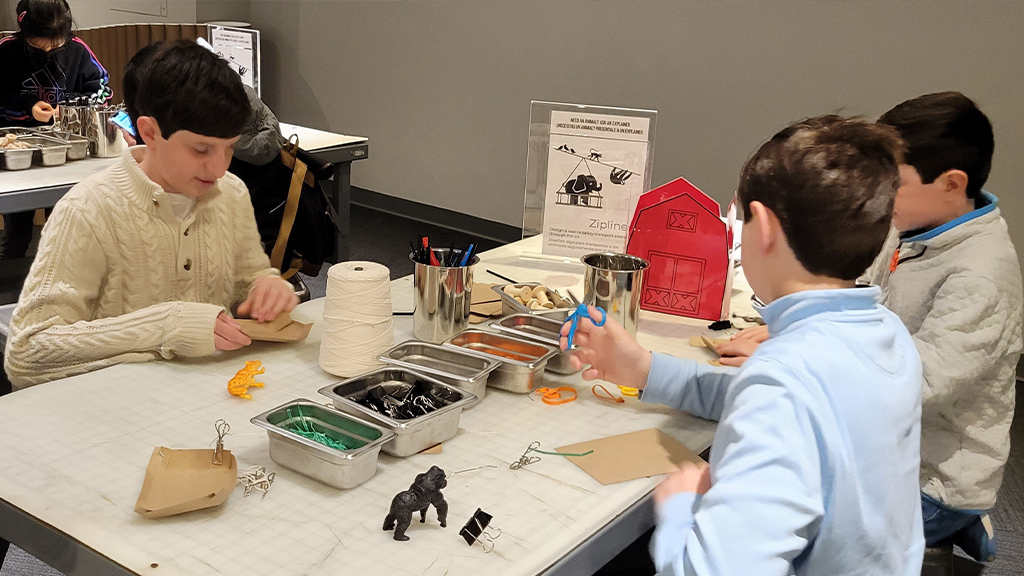
An informal learning environment provides a unique opportunity to observe the emergence of competition in engineering education. Competition is commonly used in engineering education (e.g., FIRST LEGO League and Technovation Girls) to support students’ motivation, problem-solving skills, collaboration, and other adaptive learning outcomes (Graffin et al. 2022; Evripidou et al. 2020). However, studies also found that competitive learning environments may lead to aversive learning experiences for students, especially for girls (Chiang et al. 2023). Most studies on competition in engineering have focused on structured classroom settings (English and Moore 2018), leaving a gap in understanding its impact in informal learning environments such as afterschool clubs and science museums, where learning is spontaneous and occurs with families and friends. As informal engineering education gains importance, especially for young children (Cardella, Svarovsky, and Pattison 2020), it becomes crucial for educators and researchers to explore the nature of competitive learning environments, children's competitive behaviors, and the influence of these behaviors on children and families’ engagement in engineering learning.
To fill this gap, we used a qualitative approach with structured observations and interviews to explore young children (aged 7 to 14 years old) and their family's goals in engineering design activities at a science museum through the lens of goal orientation (Pintrich 2000). Goal orientation differentiates if a learner focuses on mastering skills and knowledge (mastery goal orientation) or outperforming others in a learning task (performance goal orientation). It provides a structured framework to examine the learners’ self-regulated intentions for the learning task and the influence of the social environment (e.g., classroom goals) on their adoption of goal orientations (Anderman and Patrick 2012). Using this framework, we investigated how children interpreted the challenges of open-ended engineering design activities. In particular, we explored the ways that competitive behaviors and intentions may be promoted, facilitated, or diminished by family members and the design of the activities in informal settings, and how these competitive behaviors and intentions may be related to children’s engineering practices. The aim was to provide clear, notable examples of different ways to recognize children’s engagement (or disengagement) in competition in informal engineering design activities. The findings can help educators and researchers better understand competitive behaviors and integrate competition in facilitating and designing engineering activities for young children and their families.
Theoretical Framework
Goal orientation, or achievement goal orientation, refers to an individual's disposition or inclination toward achieving a particular objective or outcome. It is a psychological construct that plays a vital role in academic success and is an essential component of effective learning (Pintrich 2000). An extensive body of research on goal orientation has been conducted in formal education across various disciplines with respect to two primary types of goals: mastery and performance. Mastery goal orientation refers to a learner's focus on mastering a particular skill or subject matter for internal rewards such as joy and interest. In contrast, performance goal orientation is more concerned with achieving better grades, winning over classmates, or earning external rewards such as prizes or recognition.
In general, studies had found that students who have a mastery goal orientation tend to have a deep understanding of the subject matter, high levels of engagement, and intrinsic motivation in subjects. They view learning as a process and are driven by a desire to acquire knowledge, skills, and competence. Such students are likely to persist in the face of obstacles and setbacks and have a growth mindset that allows them to view failures as opportunities for learning and improvement. Students who adopt performance goal orientation, on the other hand, are likely to focus on the outcomes and the external rewards associated with success (Vandewalle et al. 2019). Performance goal orientation can further be divided into performance-approach (e.g., a desire to outperform peers by earning good grades) and performance-avoidance orientation (e.g., a desire to avoid losing to peers). Studies show mixed results for students with performance-approach goal orientation. Some students may demonstrate strong motivation in learning and competition, develop high self-efficacy, and focus on specific outcomes (e.g., grades), yet some may result in pursuing surface-level learning strategies such as rote memorization or lacking sustained engagement in learning. Meanwhile, studies also showed that performance-avoidance goal orientation is consistently associated with maladaptive learning outcomes, such as anxiety, self-handicapping, and lower grades (Pintrich 2000)1.
Children’s goal orientation can be significantly influenced by their social environments such as personal relationships, group dynamics, and facilitation (Anderman and Patrick 2012). For example, a teacher can influence students' goal orientations by setting up classroom goals either focusing on their performance on standardized exams or their development of personal interest. In informal settings like science museums, young children’s social environment is often constructed by their families and museum facilitators. The informal settings usually provide ample opportunities for family members to interact with each other, playing and exploring new tools, materials, and knowledge together. However, there has been limited attention on children’s mindset around competition in such an environment and about how their goal orientations may be influenced by caregivers, siblings, and others (e.g., museum educators) in such learning experiences. How do parents, for example, encourage engagement in competitive design challenges for a mastery-oriented child? How do siblings compete with each other in an interactive hands-on exhibit? For informal engineering education, in which competition is a common element used to support engagement (e.g., in educational robotics), such information is critical for educators to recognize different goal orientations and think about how they might intervene to better support these learners.
Method
We recruited 192 children (ages 7–14, 51% female, 49% male) with their families at the two drop-in engineering design activities in a science museum during regular museum hours. These activities were based on commonly used engineering activities: An air-powered vehicle challenge (Around the World) and a zipline challenge (Animal Transport) (see Table 1). The activities were selected based on their clear, specific engineering concepts and goals and the opportunities for divergent design solutions. The activities invite young children to consider the users of their designs and to define multiple and complex engineering challenges within the problem. These activities were adopted and modified from classic engineering design activities, and they were developed and tested through the prior National Science Foundation–supported project that aimed to design inclusive engineering activities for girls by evoking empathy using narrative elements (DRL 1712803).
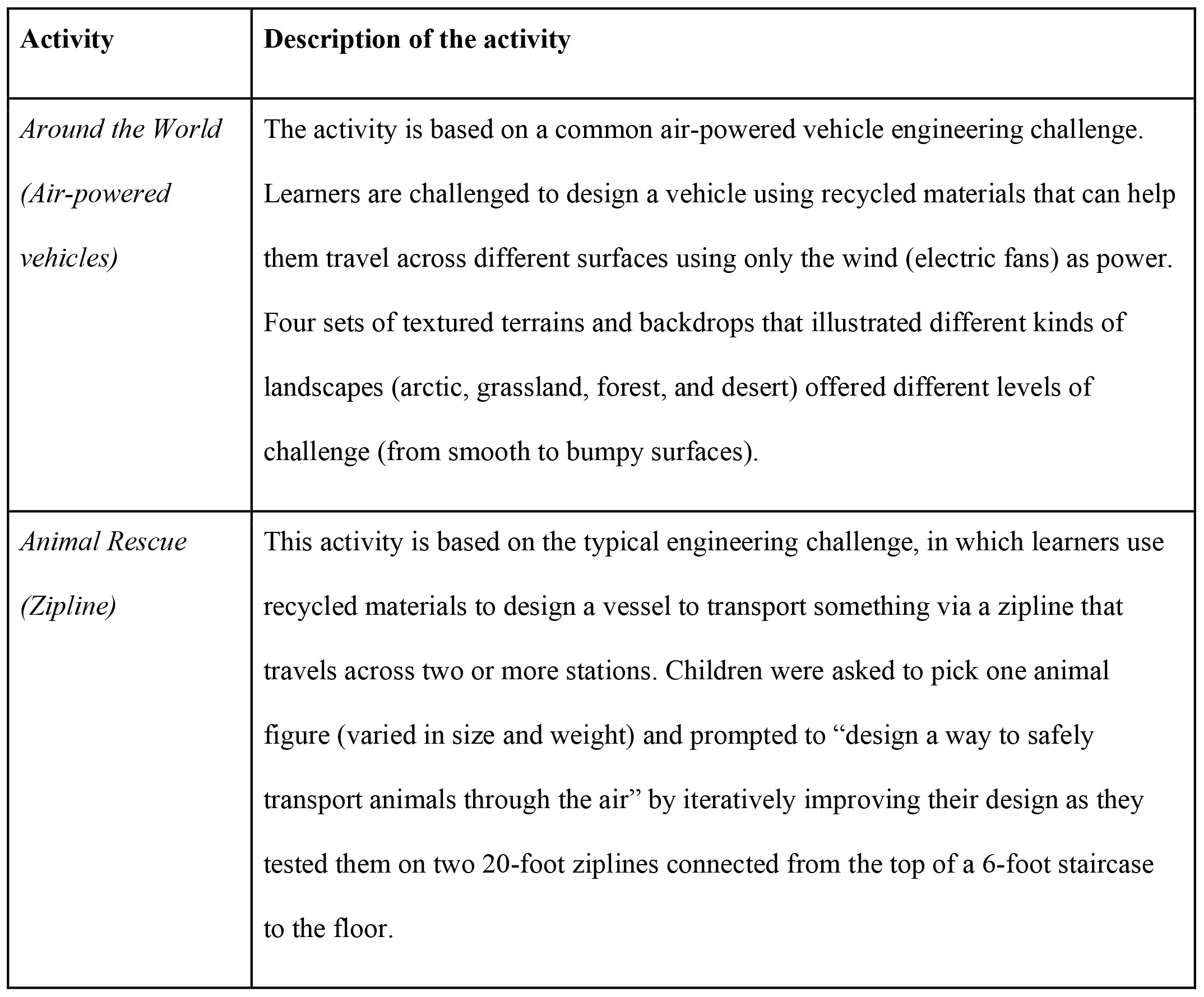
Click here for larger image
We observed the whole family’s engagement with the activities and briefly interviewed at least one child in the group before they left. The observation protocol and interview questions (e.g., What were you thinking about when you were looking at other people’s work?) for children’s goal orientations were developed based on clinical interviews with children and families in a pilot study (Liu and Bennett 2022). The observational indicators we developed to capture mastery goal orientation centered around whether children focused on understanding and defining the engineering problems and sought internal rewards for doing the activity. Specifically, we observed if children asked questions about the design problem, learned how to use the tools or materials, or discussed problems and/or solutions of their testing results with others. We also documented if children expressed interest, enjoyment, or excitement in learning about engineering and if they went beyond the problem prompt to define their own problems to solve (internal achievement). For performance goal orientation, we observed if children indicated that they wanted to compete with others in the learning task. Typical indicators included children comparing the quality of their own designs to others (e.g., “Mine is better!”), competing to finish their design first, or anything that the children agreed to compete with each other about (e.g., “Mine goes farther!”). Other indicators included if they showed off their work to other people to gain praise or to intimidate others, or if they challenged or devalued other children’s work.
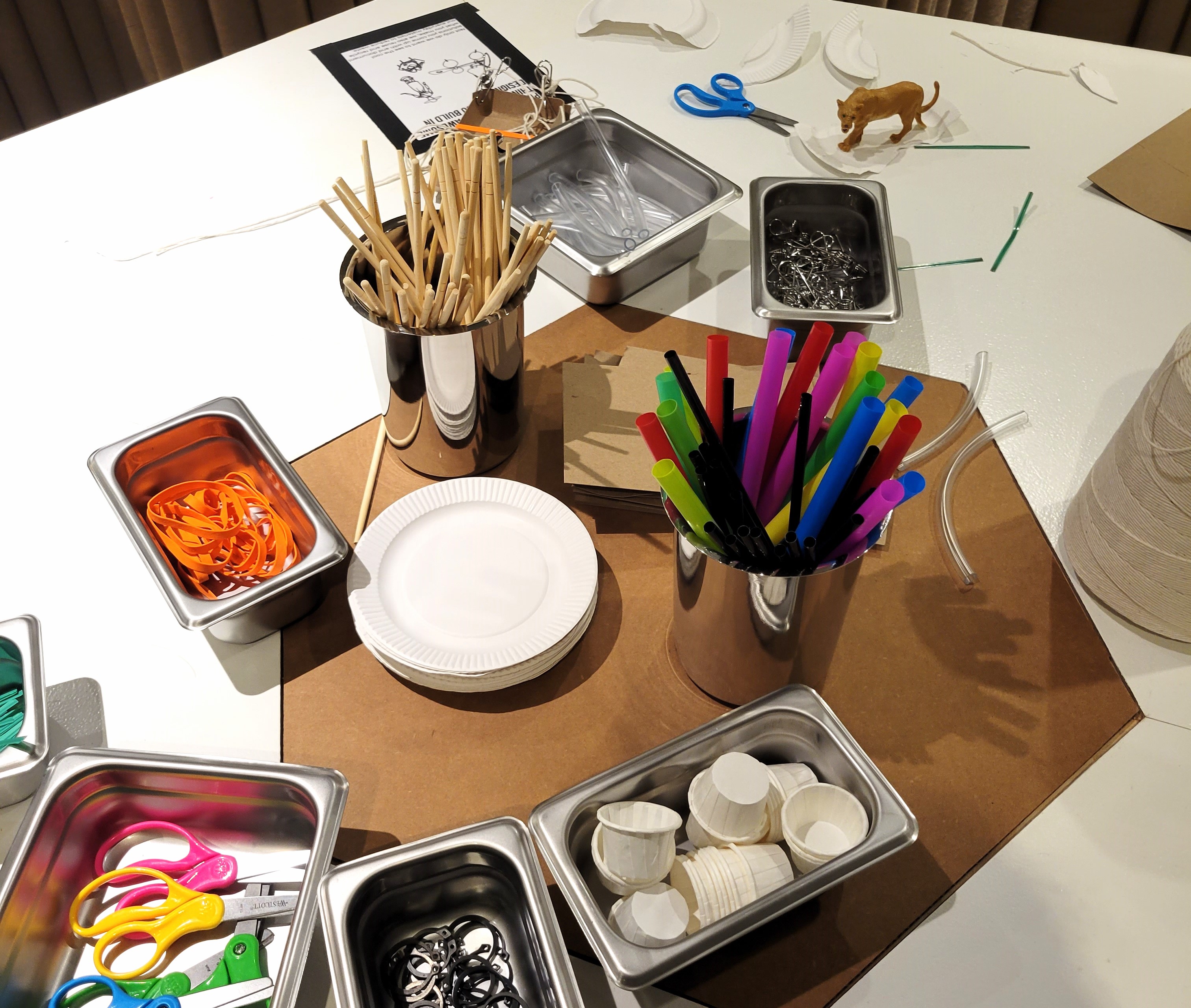
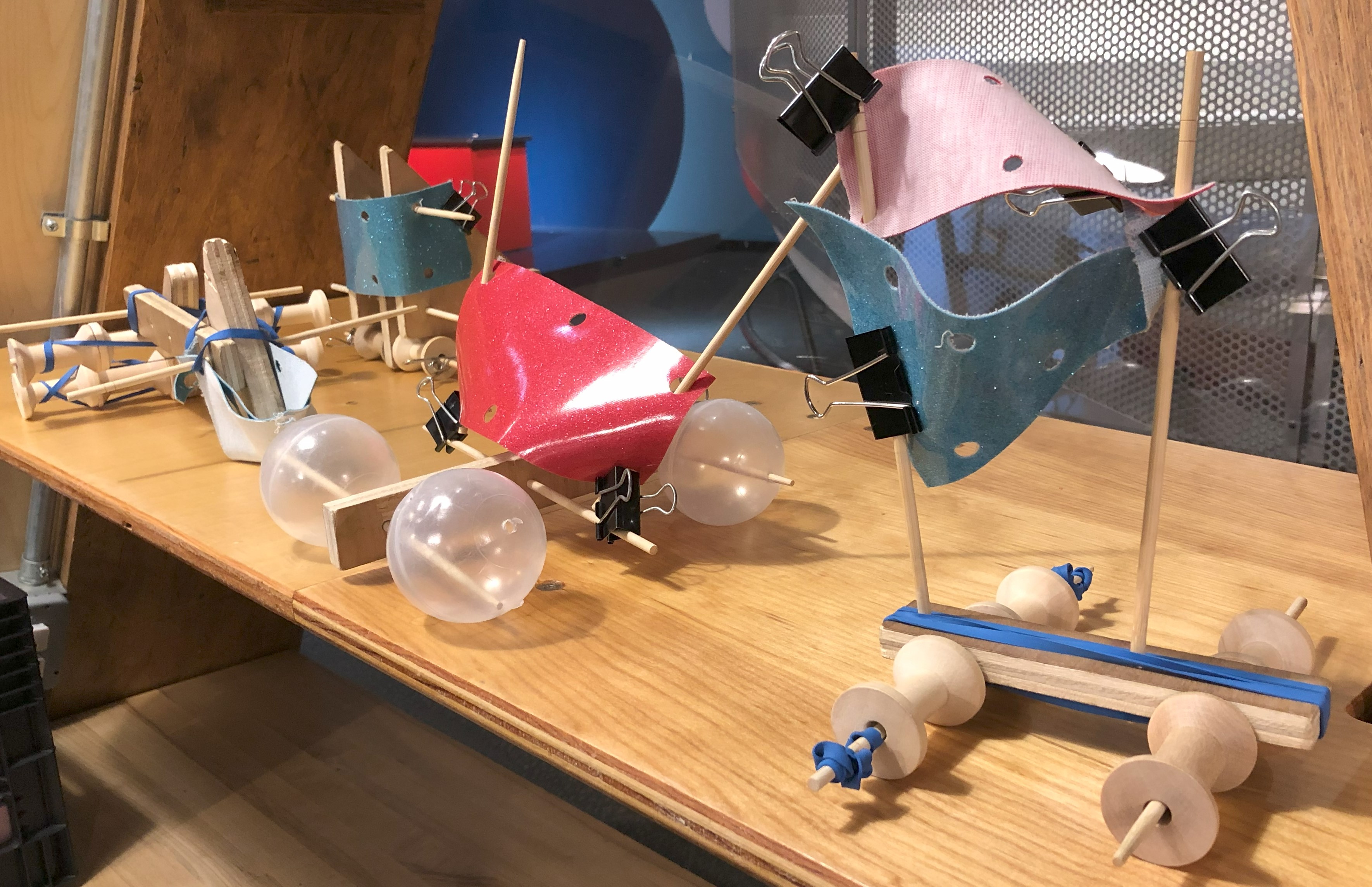
For engineering engagement, we looked for indicators of key engineering practices and habits of mind advocated for by the state and national standards and deemed critical for building more complex forms of engineering knowledge and professional practice (ASEE 2020). The observation protocol was based on recent studies that observed engineering design practices in a range of informal learning environments (Letourneau et al. 2021). In this project we focused on whether children engaged in any of the following key practices in our activities:
- Ideation: Generating potential solutions to a problem.
- Problem scoping: Defining aspects of the problem that the design should address.
- Testing: Trying out a completed design or part of the design to see how it functions.
- Iteration: Revising a design based on some form of feedback or testing.
- Persistence: Focusing on solving problems or using tools for the design.
Findings
To provide a sense of how goal orientation might be observed in informal learning environments, we provide examples and descriptions of how children with mastery and/or performance goal orientation engaged with the engineering activities and the behaviors they exhibited, and how this transpired within the context of the social space. We further discuss key factors that may be related to their goal orientations in the context of family engineering tasks.
What did children’s goal-oriented engagement look like in engineering design activities?
From our data, we noticed many children had a recognizable goal and goal orientation when joining the activity. Some children decided they wanted to compete right after learning about the design challenge of the activities (e.g., “Let’s race our vehicles), while others focused on exploring materials and making designs unique from others in the space. While children often exhibited mixed mastery-oriented and performance-oriented behaviors during the design process (e.g., taking time to figure out how a new tool works while also expressing the desire to finish their designs first), many had a clear, dominant goal orientation for their engagement in the activity. For example, when asked “What was your main goal in this activity?” most children had little hesitation articulating if they were mainly focusing on winning over other children, solving specific design challenges, or learning about the new tools. Having a dominant goal orientation was evident in almost all children across the age range and genders.
Mastery goal orientation observations
Mastery goal orientation was observed by learners’ expressed intention to learn new knowledge and master skills for intrinsic rewards. For example, we observed a 10-year-old boy build his air-powered vehicle in the Around the World activity. He came in with his mother and his 7-year-old younger sister. Although his mother was busy helping his younger sister, the boy was very enthusiastic about the activity and showed his mother everything he did, saying things like, “Hey Mom, check this out!” and “This works! It is so cool!” He also helped his mom figure out how to use ziplines. He explained to her by showing and saying: "This is how you do it [attaching the carrier to the zipline]. See how I did it with mine?" Throughout the time the family was there, the boy kept an eye on his sister’s design and was interested in helping his mother. His engagement with the activity indicated a typical mastery-oriented mindset, focusing on learning how to use different tools and materials. He was excited by the design challenge and very happy to test his work. In the interview, he shared that he believed people do worse in the activity if they do not try or do not build anything. He focused on his own idea and solutions and worked through his design by exploring different materials and conducting tests and iterations.
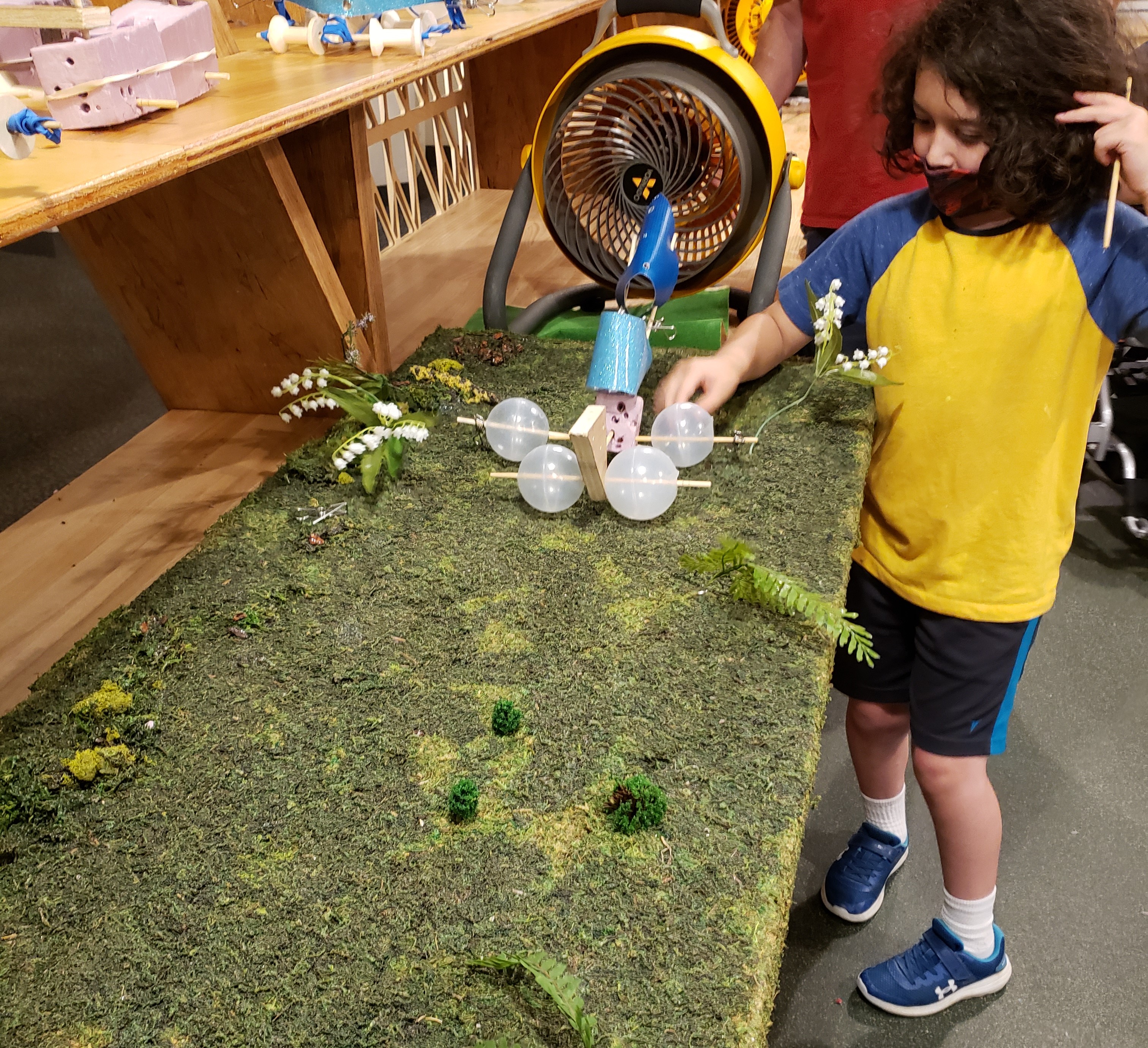
Performance goal orientation observations
Performance goal orientation was observed among children who directly expressed the desire to compete with others or gain recognition and rewards. For example, in the Animal Transport activity, we observed two siblings who were very competitive from the beginning of making their designs. The family group included the mother, an older boy (9 years old), and a younger sister (7 years old). The boy not only wanted to build his animal carrier faster than his sister but also wanted to have a better design than hers. He specifically challenged his sister’s work by saying, “That's not going to work… It needs to be more like mine" and then showed off his design as a way to compete with his sister rather than help his sister improve her design. He also competed with her about who could finish their design first. He kept asking his sister, “Are you done yet?” and questioned her slow design process by saying, “How are you going to know if it works if you don't try it?" "What a slow poke." He also told her that he “doesn’t think that [her design] is going to work.” To ensure his design would work, the boy was dedicated to solving the problem at hand, conducting multiple rounds of testing and modifying his vehicle. Matching with the observational evidence, he expressed later in the interview that he had paid close attention to his sister’s design during their time at the activity, and his main goal in the activities was to compete with and win to ensure his design was better than his younger sister’s design.
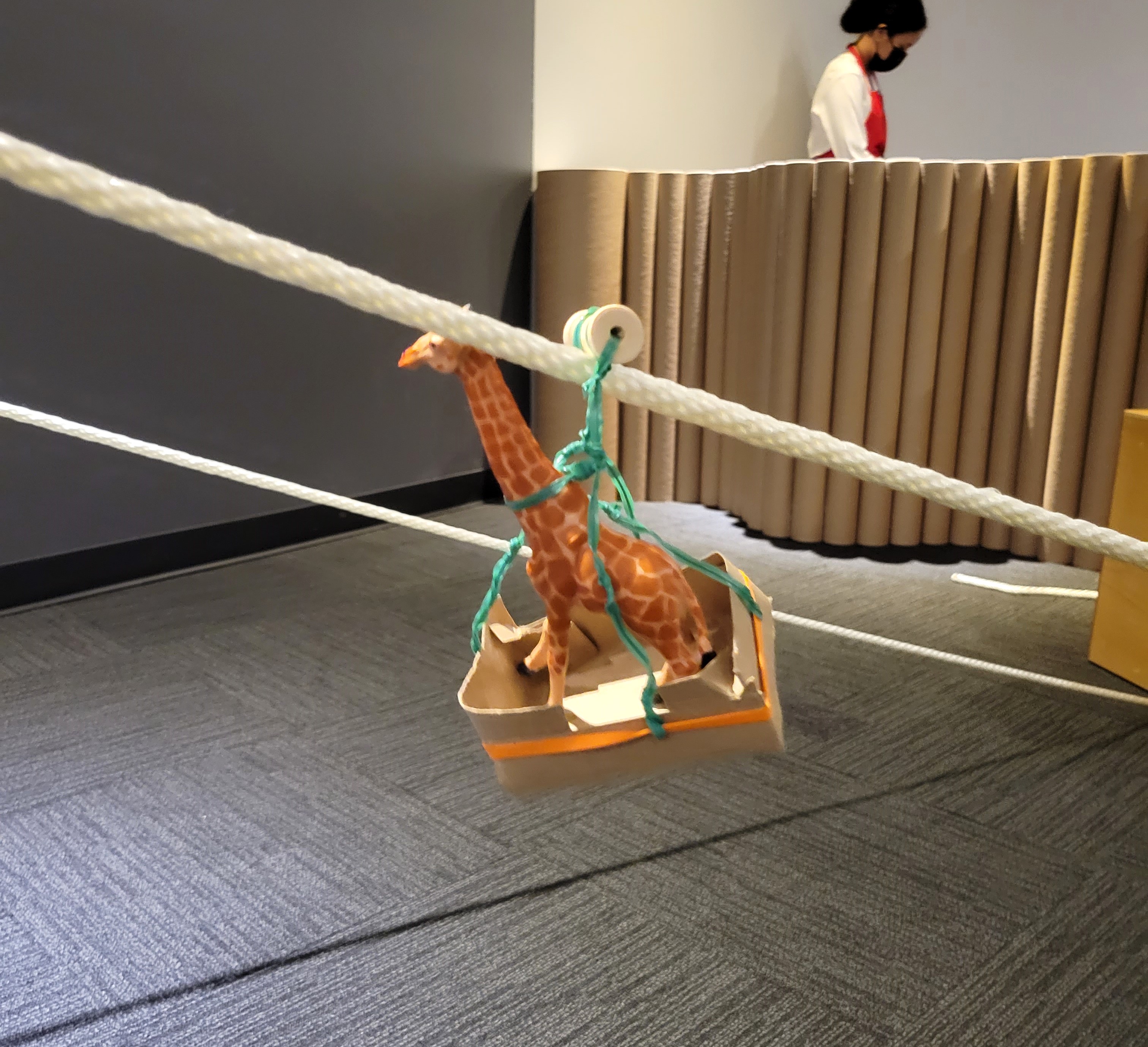
Goal orientations with engineering practices
To better understand how goal orientation may factor into children’s engagement with engineering, we investigated the relationship between their goal orientation and specific engineering design practices (i.e., ideation, problem scoping, iteration, testing, and persistence) that they exhibited. We observed that both performance- and mastery-oriented children engaged in ideation practices by generating potential solutions to the initial engineering problem prompt. Particularly, we observed that mastery-oriented children were likely to create multiple design solutions, such as designing a different vehicle without using sails to capture the wind after designing one with sails or making a new structure to make the carrier more comfortable for the animal to travel a zipline. Compared to performance-oriented children, mastery-oriented children were also more likely to brainstorm different aspects of the design challenges and consider different constraints even after they solved the problem in their first design. On the other hand, performance-oriented children were likely to focus and work on one design until they solved the specific engineering problem and challenge, won the competition, or gained the results they expected (e.g., praise from parents), and were less likely to make another design or solve another design problem after their successes.
For problem scoping, both performance- and mastery-oriented children identified one or more key problems in creating their designs. The performance-oriented children usually focused on practical or technical problems that were essential to the success of the engineering challenge, such as the height of the wheels of the vehicle to make sure the vehicle could go through bumps on different terrains. Mastery-oriented children tended to consider other problems embedded in the engineering challenges such as the needs of the users of the design. For example, they might focus on making sure the vehicle has seats for people to sit and drive, or if the carrier is balanced and safe for animals so they would not fall out.
We observed similar amounts and quality of testing, iteration, and persistence from both mastery- and performance-oriented children. Overall, children were active and engaged in designing their vehicles or carriers, testing materials and their designs, finding and fixing small problems, and persisting on the problems at hand.
Social influences on goal orientation
We found that the interactions among siblings, family members, and other children in the space could potentially be a strong influence on the child’s goal-oriented behaviors. For example, we observed that the oldest child often wanted to ensure that their design was the best or better than their younger siblings’ designs, and this would lead to a competitive engagement, such as prompting others to compare and comment on others’ work. In one large family with four children, for instance, the oldest boy (14 years old) announced “Let’s see who does best!” when the family walked into the zipline activity. He then took charge of telling his siblings how to compete by saying, “You don’t have to finish first, but you need to make sure it works” to ensure that everyone can compete at the end. He also made fun of others’ work by saying, “You think that is gonna work? That doesn’t look good.” He even orchestrated the competition by patiently waiting for everyone to finish their designs and had everyone test together. He would make noises after each person tested and said, "Too bad!" if the design did not slide down the zipline. As the result of this child, it seemed that there was little room for other siblings, who may not prefer to compete, to engage with this activity differently.
Similarly, we also observed how mastery goal orientation can be promoted by family members within a group. One interesting indicator that generated from our observations was altruistic behaviors expressed by siblings, such as a child helping a younger sibling use an unfamiliar material or tool, or brainstorming solutions with family members or others after testing their designs. When a child was teaching and helping others, they seemed less likely to compete with others, and instead spent time figuring out how things worked and exploring materials and design problems. These kinds of interactions could also be guided by caregivers or facilitators working alongside the children and asking for help or questions about the design problem (e.g., What should we work on this zipline carrier?), children’s material choices and plans (e.g., How did you make the sail for the vehicle?), and testing results and potential solutions (e.g., What happened? What did you learn/notice?).
In fact, we observed that caregivers may play an important role in co-constructing goal orientations with their children with the intention of trying to engage children in the activity. For example, caregivers might compete with their children by creating their own design alongside the children, or if there is more than one caregiver and multiple children in a group, caregivers may break up into two teams that compete against each other. This kind of team competition provided ample opportunities for caregivers to focus on and model engineering processes and to encourage collaboration and problem-solving to strengthen children’s engagement with the engineering problems. In the meantime, it also provided opportunities for caregivers to support mastery goal orientation by scaffolding and building knowledge about related engineering concepts.
However, caregivers’ involvement was not evenly distributed among our participants. While some caregivers spent the entire time working with their children, some were absent or passively sitting alongside their children. In addition to cultural differences in parenting and learning, one of the reasons might be because this kind of engagement requires caregivers to feel agency in constructing their own learning experience in such environments and to be actively engaged with the activities themselves, which may be unfamiliar for families who have less prior experience with informal engineering learning spaces.
How to Support Children’s Goal Orientations in Informal Engineering Education
How do these findings help educators in formal and informal education better support children’s learning in engineering? First, even though prior research has indicated the benefits of mastery goal orientation and the potential concerns around performance goal orientation, it is not our specific intention to advocate for either goal orientation. There are substantial studies underlining the strength of using competition in engineering education when the curriculum and learning activities were carefully and mindfully designed and implemented with needed supports (Chiang et al. 2023; Graffin et al. 2022). In our study, we observed how caregivers could facilitate an engaging and productive competition among siblings by guiding engineering practices and encouraging positive interactions. The purpose of this article is to increase the awareness of how goal orientation can be taken into account when trying to set up a learning environment that can accommodate children and families who may be more performance- or mastery-oriented in their overall ways of learning.
One of the key takeaways of our study is that caregivers and siblings may play a role in shaping and co-constructing children’s goal orientations, which in turn may contribute to their productive engagement in informal engineering experiences. Overall, we observed that more families created a competitive environment than a non-competitive environment and that the social interactions among family members can be easily skewed by one excited, competitive child or parent. On the other hand, mastery goal orientation may emerge when it was encouraged by siblings or caregivers teaching each other about tools and materials that they used or what they learned from testing their design solutions.
While further studies will be needed to provide constructed and evidence-based suggestions and strategies, our findings showed the need for educators to pay more attention to how individuals’ competitive and mastery behaviors can shape the social learning environment in engineering tasks and to consider what they can do to promote productive and inclusive engagement for all. For example, asking children to compare their design solutions with others might help set up a performance goal orientation environment that may help children persist in solving specific technical engineering problems. On the other hand, cues and supports in the learning environment that encourage and celebrate sharing knowledge and explanations with others might promote a more mastery goal orientation environment, which may help children and parents focus on understanding and mastering the engineering skills or principles. We encourage educators, facilitators, and activity designers to ask how their engineering learning environment is set up to create spaces for learners with different orientations. Questions that we used to guide our study include:
- What does competition look like in my program/exhibit/activity? How do I know?
- What are children and families competing (or not competing) about? Who is leading and who is following?
- How does competition emerge from the way we set up the problem frame and the activity? What was intentional or not intentional?
- How do (or if) children shift from one goal orientation to another? How might we (and the children) redefine what success or winning means in the space?
Through reexamining the learning environment, educators can foster engineering learning experiences that promote engagement in particular engineering practices by carefully considering prompts and facilitation that support specific learning goals that they are after. This can have benefits and challenges to children’s full engagement in engineering learning. We encourage future informal engineering education professionals to consider the underlying assumptions of the learning experiences that they create, especially around competition, and how it is possible to support both goal orientations to better engage with all learners.
Conclusion
The purpose of this study is to explore the role that goal orientation can play in better understanding and conceptualizing children’s and their families' engagement with engineering design activities in informal learning environments. Our aim is to depict the diverse ways in which children engage with engineering design processes and practices and to highlight potential factors that may influence their experiences. The results indicate the complexity of children’s goal orientations and potential contextual factors that may influence their goal orientations and yield new insights for future researchers and educators to better support children and their families to engage with engineering in informal learning environments.
ChangChia Liu is a Senior Research Associate and Dorothy Bennett is the Director of Creative Pedagogy, both at the New York Hall of Science in Flushing, New York.
Endnote
1. Some motivation researchers also conceptualized a mastery-avoidance goal orientation, suggesting a two-by-two matrix of goal orientations, namely performance-approach, performance-avoidance, mastery-approach, and mastery-avoidance. However, studies also indicated that the mastery-avoidance goal orientation may not be conceptually valid or empirically supported, especially for young children (for more information, please see comprehensive reviews by Kaplan and Maehr 2007, and Vandewalle et al. 2019). In addition, our prior study (Liu and Bennett 2022) also showed that young children may not separate performance-approach and performance-avoidance goal orientations, and instead, had a general concept of performance goal orientation. In this study, we categorized children’s goal orientations into two simplified categories: performance and mastery goal orientation.
Engineering Inclusion Science and Engineering Practices STEM Informal Education


